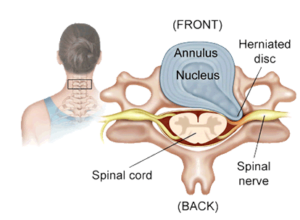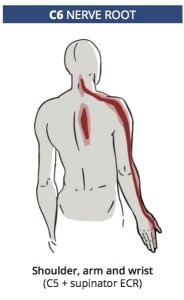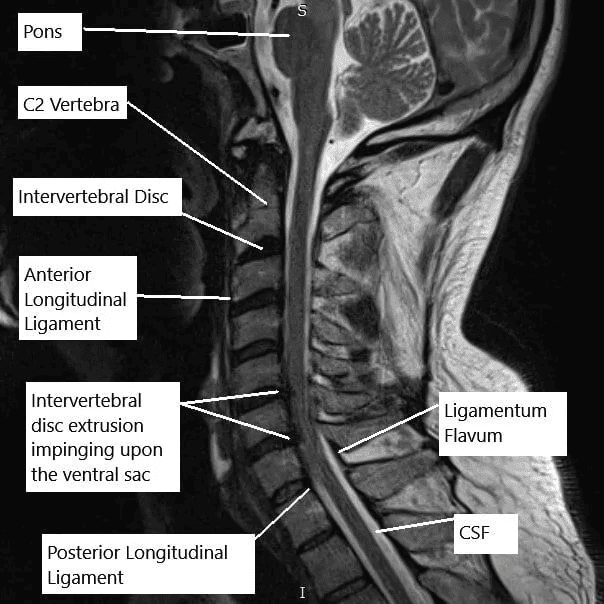Introduction
In today’s fast-paced world, the increasing prevalence of neck and spine-related disorders is a growing concern. Among these, C5-C6 disc bulge is a condition that can significantly impact an individual’s quality of life. This article delves into the causes, symptoms, and diagnosis of C5-C6 disc bulge, with a particular focus on non-surgical treatments such as cervical epidural injections, cervical prolotherapy, and physical therapy.
Understanding C5-C6 Disc Bulge
The cervical spine, consisting of seven vertebrae (C1-C7), is a crucial part of the human anatomy that supports the head’s weight and facilitates its movements. Between each pair of cervical vertebrae lies an intervertebral disc, which acts as a cushion, absorbing shocks and allowing for flexibility. The C5-C6 disc, situated between the fifth and sixth cervical vertebrae, plays a vital role in neck movement. A disc bulge at this level refers to an abnormal protrusion or displacement of the disc material beyond its normal boundaries.se can include X-rays, MRI, CT Scan, and Discogram.

Causes of C5-C6 Disc Bulge
The development of a C5-C6 disc bulge can be attributed to various factors, including:
- Age-Related Degeneration : One of the primary causes is the natural aging process. Over time, the discs in the cervical spine can lose their elasticity and water content, making them more susceptible to bulging or herniation.
- Trauma or Injury : Accidents, falls, or sports-related injuries can exert force on the neck, leading to disc bulges.
- Repetitive Strain : Activities that involve repetitive neck movements, such as poor posture while using electronic devices, can contribute to disc bulges over time.
- Genetic Factors : Some individuals may have a genetic predisposition to developing disc problems.
- Occupational Factors : Jobs that require prolonged sitting, especially with poor ergonomics, can increase the risk of disc bulges.
- Obesity : Excess body weight can place additional stress on the cervical spine, increasing the likelihood of disc issues.
Understanding these causes is essential in devising effective treatment plans and preventive measures.
Symptoms of C5-C6 Disc
Recognizing the symptoms of C5-C6 disc bulge is crucial for timely diagnosis and intervention. Common symptoms include:
- Neck Pain : Persistent, localized pain in the neck region is a hallmark symptom of C5-C6 disc bulge.
- Radiating Pain : Pain may radiate into the shoulders, arms, and even down to the fingers. This is often described as a burning or tingling sensation.
- Muscle Weakness : Weakness in the muscles supplied by the affected nerve roots can occur, leading to difficulties with fine motor skills.
- Numbness and Tingling : Sensory disturbances like numbness and tingling are frequently reported in the upper limbs.
- Reduced Range of Motion : Stiffness and a reduced ability to move the neck comfortably can be experienced.
- Headaches : Persistent headaches, often originating from the neck, may be associated with C5-C6 disc bulge.
These symptoms can significantly affect an individual’s daily life and should not be ignored. Early diagnosis and appropriate treatment can prevent the condition from worsening.

Role of MRI in Diagnosis
Magnetic Resonance Imaging (MRI) plays a pivotal role in diagnosing C5-C6 disc bulge. Unlike traditional X-rays, MRI provides detailed images of soft tissues like intervertebral discs and nerve roots. It allows healthcare professionals to assess the extent of the bulge, identify nerve compression, and rule out other potential causes of the symptoms.
A study published in the Journal of Clinical Medicine (2019) [1] highlighted the superior sensitivity of MRI in diagnosing cervical disc disorders, emphasizing its crucial role in treatment planning.

Non-Surgical Treatments
Non-surgical treatments are often the first line of defense against C5-C6 disc bulge. They aim to relieve pain, reduce inflammation, and improve the overall function of the cervical spine. Here, we focus on three non-surgical treatment options
Cervical Epidural Injections
Cervical epidural injections are a well-established non-surgical treatment for C5-C6 disc bulge. They involve the injection of corticosteroids directly into the epidural space near the affected nerve roots. These injections provide both diagnostic and therapeutic benefits.
- Diagnostic Benefit : By temporarily relieving pain, cervical epidural injections help confirm the source of pain as the C5-C6 disc bulge. This assists healthcare providers in tailoring the treatment plan.
- Therapeutic Benefit : The corticosteroids reduce inflammation, alleviating pain and discomfort. A study in the Journal of Orthopaedic Surgery and Research (2019) [2] found that cervical epidural injections provided significant pain relief in patients with cervical disc herniation.
Cervical Prolotherapy
Cervical prolotherapy, a less commonly known treatment, involves the injection of a proliferative solution, often containing dextrose or other irritants, into the ligaments and tendons surrounding the C5-C6 vertebrae. This stimulates the body’s natural healing processes, leading to tissue repair and strengthening.
A study in the European Journal of Physical and Rehabilitation Medicine (2017) [3] highlighted the effectiveness of prolotherapy in reducing pain and disability in patients with cervical instability related to disc degeneration.
Physical Therapy
Physical therapy is a cornerstone of non-surgical treatment for C5-C6 disc bulge. It focuses on improving posture, strengthening neck and shoulder muscles, and increasing range of motion. Physical therapists employ various techniques, including manual therapy, exercises, and postural training.
A study published in the Journal of Orthopaedic Science (2018) [4] demonstrated that physical therapy significantly reduced pain and improved functional outcomes in patients with cervical disc herniation.
FAQs
A C5-C6 disc bulge can be serious if it compresses nerves, leading to symptoms like neck pain, arm weakness, or numbness. Severity varies; early diagnosis and treatment are crucial.
Sleep on your back or side with a supportive pillow to maintain neck alignment. Avoid stomach sleeping, and consider a firm mattress to reduce pressure on the cervical spine.
Yes, many C5-C6 disc bulges improve with non-surgical treatments like physical therapy, medications, and lifestyle changes. Surgery is typically considered only if conservative methods fail.
Recovery varies, but many individuals experience symptom relief within 6 to 12 weeks of consistent non-surgical treatment, including physical therapy and activity modification.
Surgery may be considered if symptoms persist beyond six months despite non-surgical treatments, or if there's significant nerve compression causing weakness or loss of function.
Conclusion
C5-C6 disc bulge is a common cervical spine condition that can cause debilitating pain and discomfort. Understanding its causes, recognizing its symptoms, and obtaining an accurate diagnosis through MRI are critical steps in effective management. Non-surgical treatments, including cervical epidural injections, cervical prolotherapy, and physical therapy, offer promising options for pain relief and functional improvement. As research continues to shed light on these treatments’ efficacy, individuals suffering from C5-C6 disc bulge can find hope in non-invasive interventions that can enhance their quality of life.
References
- de Almeida AM, Botelho J, Machado V, Mendes JJ, Manso C, González-López S. Comparison of the Efficacy of Two Protocol Treatments in Patients with Symptomatic Disc Displacement without Reduction: A Randomized Controlled Trial. J Clin Med. 2023 Apr 30;12(9):3228. doi: 10.3390/jcm12093228. PMID: 37176666; PMCID: PMC10179338..
- Zhang J, Zhang W, Sun T, Wang J, Li Y, Liu J, Li Z. The Influence of Intervertebral Disc Microenvironment on the Biological Behavior of Engrafted Mesenchymal Stem Cells. Stem Cells Int. 2022 Nov 7;2022:8671482. doi: 10.1155/2022/8671482. PMID: 36387746; PMCID: PMC9663214.
- https://www.researchgate.net/publication/ 8603385 Critical Review of Prolotherapy Osteoarthritis Low Back Pain and other Musculoskeletal Conditions A Physiatric Perspective
- Omori M, Shibuya S, Nakajima T, Endoh T, Suzuki S, Irie S, Ariyasu R, Unenaka S, Sano H, Igarashi K, Ichimura S, Ohki Y. Hand Dexterity Impairment in Patients with Cervical Myelopathy: A New Quantitative Assessment Using a Natural Prehension Movement. Behav Neurol. 2018 Jul 4;2018:5138234. doi: 10.1155/2018/5138234. PMID: 30073036; PMCID: PMC6057419.
- MRI Diagram- Case Study: Cervical disc replacement in a 60-year-old female with cervical spine stenosis at C5-C6 and C6-C7 with radiculopathy and myelopathy https://www.cortho.org/case-studies/spine/cervical-disc-arthroplasty-case-study/





